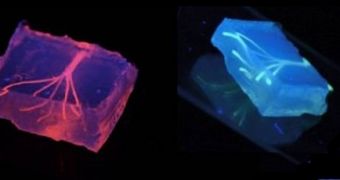3D bioprinting sometimes seems to be advancing a level of magnitude faster than all other applications of 3D printing technology. And it's things like 3D printing blood vessels that give that impression.
It feels like just yesterday the first plastic 3D printer came into being and stumbled its way into the sight of the world's cameras.
Since then, things have advanced quickly, frightfully quickly some might say, especially in the field of medical equipment and implants.
Transplants too. We won't be forgetting about the fully replaced skull any time soon, or about how substitute liver tissue has already been created.
Also, when biochemists and 3D bioprinting experts talk about fully 3D printed organs, they tend to do it in very self-assured tones, as if they're just a foregone conclusion.
In a way, they are, even if the only ones that exist right now are very poor substitutes. Things are moving quickly though.
In fact, something even more tricky to 3D print has been achieved: a blood vessel. Well, more than one blood vessel actually.
A team of scientists from Brigham and Women's Hospital in Boston used a 3D bioprinter to make an agarose fiber template.
Then, they used the template as a mold, on which they built the blood vessels themselves. The mold was then covered in hydrogel, a substance not too dissimilar to gelatin. The hydrogel acted like a cast, which was reinforced by means of photocrosslinks.
So the new blood vessels are, in essence, the result of a combination between advances in 3D bioprinting technology and biomaterials.
We're not really sure how they'll really help, since it's not like 3D printers can print things inside other objects.
Then again, many organs tend to be riddled with veins and arteries, not to mention capillaries, and the same goes for muscles too. Stem cells can only do so much on their own.
So the new breakthrough on the part of the Boston Brigham and Women's Hospital might actually become essential in future 3D bioprinting endeavors.
The most important thing about the new blood vessels is that the fiber templates are strong enough to be physically removed, thus making the channels. Otherwise, they would have had to dissolve the template layers, which would have done harm to the cells trapped in the surrounding gel. That's how Ali Khademhosseini, the senior study author, explains it.
He also says that 3D printing technology could eventually be used not just for drug research, but also to make transplantable tissues that are customized to suit each patient's needs.

 14 DAY TRIAL //
14 DAY TRIAL //